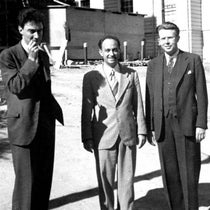Scientist of the Day - Arabella Buckley
Arabella Buckley, an English author of popular science books, was born Oct. 24, 1840, in Brighton, into a well-to-do family (her younger brother became a justice of the high court and eventually Baron Wrenbury). Her father was a reverend, and I don't know what role he played in Arabella's education, but somehow, she became a Darwinian upon the publication of the Origin of Species in 1859.
At the age of 24, Buckley was hired by Charles Lyell, the eminent geologist, to be his personal secretary. Lyell had belatedly converted to Darwinian evolution himself about that time, so she was probably a good fit. She held that job for 11 years, until Lyell's death in 1875. Immediately thereafter, she published her first book, A Short History of Natural Science (1876). We do not own this book, so I have never read it or even looked at it, but Buckley must have heaped some high praise on Darwin and Lyell in the later chapters, for Darwin himself wrote her a letter praising her efforts (with a few nits to pick as well), which no doubt thrilled the young woman, now 36 years old. You can read the brief letter on the Darwin Correspondence website, if you are interested, as well as several other letters that passed back and forth between the two before Darwin’s death in 1882.
Perhaps those interchanges inspired Buckley to write her own evolutionary book, aimed at the common reader. In 1881, she published Life and Her Children, in which she looked at the evolution of life from its primitive origins through the invertebrates and insects. We do not have that book either. She followed it up with a sequel, Winners in Life's Race, or the Great Backboned Family (1882). This book we do have, in a first edition, and all the illustrations here are taken from our copy of this work.
Buckley wrote all her books for an audience of educated people who happened to have been uneducated in science, and for older children who were curious about the world. She did not attempt to discuss the mechanism of Darwinian evolution, natural selection, but rather wanted just to establish the fact that life was different in the past, and that we learn about life in early times from geology, fossils, and comparative anatomy.
As one might expect in a book intended to attract readers to science, there are many illustrations, wood engravings by someone she calls only Mr. Carreras, jun., and whom I surmise to be Theo Carreras, a known book illustrator of the time. Since I can only show a few of these here, I decided to focus on the headpieces to each chapter, a genre of book illustration that I especially admire. As the name suggests, headpieces stand at the head of a body of text, and serve as a welcome and an introduction to the subject matter that follows.
We chose the headpiece to chapter 3, the first land dwellers (“Air-Breathers,” first image); “Reptiles in their Palmy Days,” introducing chapter 5 (third image); the “First Known Land Bird,” for chapter 7, providing an excellent restoration of the recently discovered Archaeopteryx (fourth image); the tiny mice-like mammals that constituted the “First Known Milk Givers,” for chapter 8 (fifth image); and the modern-day mammals that emerged after the Ice Age, “When the Cold Had Passed Away”, chapter 12 (sixth image). These are all lovely, indeed charming, wood engravings. Mr. Carreras jun. did his job well, and Ms. Buckley guided his efforts astutely.
Our copy of Winners in Life’s Race, although a first edition, has been rebound, so it is missing its original gold-stamped binding. Either Buckley or her publisher, Edward Stanford, wisely realized that if you are trying to attract readers to a new discipline, you first need to attract them to the book itself, and what better way to do that than with a beautiful binding. We happen to have two other Buckley books, The Fairy-Land of Science (1879; ours is an 1887 edition), and Through Magic Glasses (1890), in their original bindings, which as you can see (seventh image) are quite splendid. These two books are different from Winners, each a collection of essays on such topics as “A piece of coal” or “A drop of water.” They are crammed with lovely illustrations, and one book even harkens back to the days of the illuminated initial letter. We will look at both in a future post.
As you may have noticed, there is no surviving portrait of Arabella Buckley. That is a shame.
William B. Ashworth, Jr., Consultant for the History of Science, Linda Hall Library and Associate Professor emeritus, Department of History, University of Missouri-Kansas City. Comments or corrections are welcome; please direct to ashworthw@umkc.edu.













